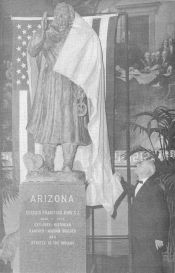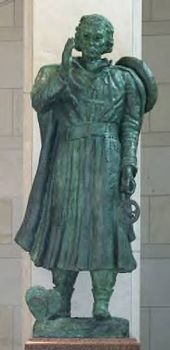Dedication of State of Arizona's Kino Statue
Rotunda of the U.S. Capitol
Arizona Admission Day - February 14, 1965
U.S. Capitol Kino Statue Section Page
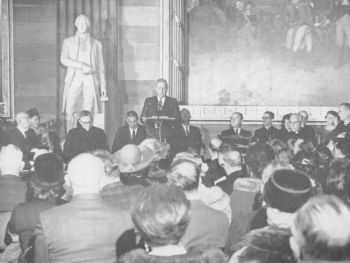
Opening Remarks and Introductions
Opening Remarks and Introductions
James M. Murphy, Master of Ceremonies, at rostrum speaking. Seated (left to right): Hon. Carl Hayden, President Pro Tempore of the US Senate and Senator from Arizona; Susanne Silver-Cruys, Sculptor; Rev. Ernest J. Burrus, S.J., Historical Institute of the Jesuit Fathers; Hon. Stewart L. Udall, Secretary of the United States Department of the Interior; Hon. Samuel P. Goddard, Jr., Governor of the State of Arizona; Rev. Edwin J. McDermott, S.J.; Principal of Brophy College Preparatory High School; Hon. John J. Rhodes, Member of Congress from Arizona; Most Rev. Francis J. Green, D.D, Bishop of the Diocese of Tucson.
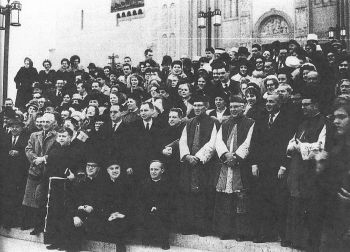
Delegation from Italy Attends Mass Before Capitol Dedication
Front Steps of National Shrine of the Immaculate Conception
Fr. Boniface Bolognani: standing 4th from right in front row
Dedication Day
The Governors of Arizona and Sonora, had officially proclaimed the week of February 7 thru February 14, "Father Kino Week in America." By using two languages, Spanish and English, their aim was to encourage better cultural and commercial relations alike between the two states.
On the morning of February 14, at 9: 00 a.m., a High Mass, honoring Father Kino was sung by the Coro Trentino of New York in the National Shrine of the Immaculate Conception. The Mass was celebrated by Msgr. Mario Ferrari, in the presence of Bishop Francis Green of Tucson, Arizona. Both the Bishop Green and Monsignor Ferrari delivered sermons.
At noontime, a dinner was served in the Manger Annapolis Hotel in Washington, D. C. Father Bolognani, president of the Honoring Committee of New York, presented the delegation from Trent, Italy; speeches were given by the Representative of the "Regione Trentina-Alto Adige," Hon. Giacomo Dusini; by the representative of the Archbishop of Trent, Msgr. Mario Ferrari; and by Hon. Dr. Bruno Fronza and Rodolfo Abram, respectively President and Secretary of the "Trentini nel Mondo" Association.
The big event of the Dedication of the Statue of the "Padre" from Trent, took place at 3:00 p.m. The Rotunda was crowed for the occasion with cameramen from CBS and ABC network, newsmen, all the big personalities from Arizona, the representative of the Government of Italy in the person of Ambassador Hon. Sergio Fenoaltea; the Ambassadors from Belgium, Spain, Mexico, the Hon. Stewart L. Udall, Secretary of Interior; Bishop Francis Green of Tucson and Auxiliary Bishop John Spence of Washington, D. D., Representatives of Congress, hundreds and hundreds of Washingtonians and more than 3,000 "Trentini" from all over the United States, many of them of the Kino family-tree.
A United States Air Force band played a music prelude. The presentation of Colors by the joint services guard and the National Anthem followed. The Invocation was given by the Bishop of Tucson to an absolutely silent and moved audience. The master of ceremonies and chairman of Kino Statue Dedication Committee of Arizona, Mr. James M. Murphy, pro ceded to present all delegations both from Arizona, Trent and New York City.
The Governor of Arizona, Hon. Samuel P. Goddard, Jr., then presented the statue to Senator Carl Hayden, in behalf of the State or Arizona. Following this, Joseph Chini of Flushing, Ohio, an elder member of the Kino-family tree in America, unveiled the statue amid flashing cameras and emotions of those present. Wreaths were placed in front of the statue by two brothers, Livio and Emanuel Chini, in the name of all the Chini or Kino in America and in Italy, and by Mario Maimone and Louis Smaniotto in the name of all "Trentini" in the United States. The historian of the Historical Institute of the Jesuits in Rome, Italy, Fr. Ernest J. Burrus, S.J., gave the dedicatory address: "Kino's Vision of the Future." His inspired speech was a detailed examination of Kino in his missionary work and in his prophetical vision of the future of Arizona and California. And he had touching words of praise for the "Trentini" and for the Trentino region which gave such a son to Mexico and to the United States of America.
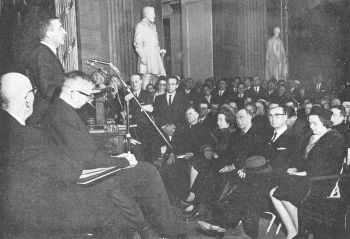
U.S Secretary of the Interior Stewart L. Udall Speaking at the Podium
US Senator Carl Hayden and President Pro Tempore of the United States Senate
and Great Spanish Colonial Historian Ernest J. Burrus, S.J. on the left.
Hon. Stewart L. Udall, Secretary of Interior of the United States, touched the audience with a few chosen words and following this, the Hon. Carl Hayden accepted the Statue in the name of Lyndon B. Johnson, President of the United States of America.
Following the ceremonies of the dedication, a reception was held in the Capitol for all the people present; meanwhile the delegation from Trent presented some gifts to the personalities present at the dedication, gold and silver medals, albums of photographs of the Kino birthplace and biographies of him, and, through the Ambassador of Italy, an artistically valuable statue of St. Francis of Assisi, the Patron Saint of Italy, to President Johnson as a memento of gratitude.
Father Boniface Bolognani, O.F.M.
"Pioneer Padre: A Biography of Eusebio Francisco Kino, S.J.
Missionary, Discoverer and Scientist" 1968
Audio Tape of Ceremony
Audio tape of the dedication ceremony is in the library of the Arizona Historical Society in Tucson.
History of Kino Statue and Discovery of Kino's Grave
US Senator Barry M. Goldwater
For nearly a century the exploits of Father Eusebio Francisco Kino have been attracting an ever-increasing audience of admirers. In his "History of the North Mexican States and Texas" (2 vols., 1884-1889), and "History of Arizona and New Mexico" (1889), Hubert Howe Bancroft noted major sources of documentary information about Kino's missionary zeal, his travels, discoveries, mapmaking, conversions, and aspirations in Pimería Alta. In 1908, when Professor Herbert Eugene Bolton spoke of Father Kino as "the creator of Pimería Alta as a Spanish province," the remarkable Jesuit missionary had acquired an energetic, devoted, and resourceful biographer. ….
In 1932 Professor Bolton reworked the introduction to one of his earlier works, "Kino's Historical Memoir of Pimería Alta" (1919), to deliver it as a speech in Tucson. The occasion was a Kino celebration, an event that had come about through the efforts of Dean Frank C. Lockwood of the University of Arizona. That address was published as "The Padre on Horseback," a small book which has been widely applauded for its concise sketch of Father Kino's accomplishments. Three years ago this was reissued by the Loyola University Press in Chicago with a new introduction by Father Bannon.
Professor Bolton noted with pride that Dean Lockwood was responsible for the formation in Arizona of the Kino Memorial Committee, "devoted to the erection of a suitable monument for the great missionary of the Southwest." Lockwood had suggested in a speech in the autumn of 1927 the placing of an "idealized statue" of Kino either at San Xavier or in Tucson. Out of this proposal the Committee was formed. Professor Bolton's address and the publication of the small book were intended to support Dean Lockwood's program. It was a period of considerable interest in Father Kino. As the result of a trip into Pimería Alta that Dean Lockwood had made with Professor Bolton and others, early in 1934, the University of Arizona published "With Father Kino on the Trail" by Lockwood. The following year one of Bolton's former students who had become professor of history at Arizona State. Teachers College [now Arizona State University], Rufus Kay Wyllys, wrote "Pioneer Padre: The Life and Times of Eusebio Francisco Kino," the first biography of Kino.
This was followed in 1936 by Bolton's big opus, "Rim of Christendom," and that same year as the result of Dean Lockwood's unflagging interest, a bas-relief memorial to Father Kino executed by the noted sculptor, Mahonri Young, was unveiled in a Tucson park. This was a compromise between the aspirations of Dean Lockwood and the exigencies of the depression. While the importance of Father Kino was being recognized in books and articles that told of his remarkable achievements, and the Kino Memorial in Tucson could be seen by visitors, the hope of bringing national recognition to Father Kino had been deferred. It was not until the Arizona Historical Foundation was organized that the loftier goal of the original Kino Memorial Committee was to be resurrected and its ultimate purpose reach fruition.
At our annual membership meeting held on December 14, 1960, the directors of the Foundation voted unanimously to make the Father Kino Memorial Statue an immediate project of the organization's program. We suggested that the citizens of Arizona should provide the means, by voluntary contributions, of commissioning an outstanding sculptor to execute a bronze statue of Father Kino for presentation on behalf of the State of Arizona to the Hall of Statuary in Washington, D. C. Our staff was instructed to proceed with this undertaking, and did so. A month later there was introduced in the Arizona House of Representatives House Joint Memorial No. 5, nominating Father Kino as Arizona's second figure in the Hall of Statuary. Upon passage of this measure, Governor Paul Fannin graciously followed our suggestions in appointing a statewide Kino Memorial Statue Committee. One of our directors, Mr. Walter Fathauer of Tucson, was chosen as its chairman. The Committee also included two more of our Arizona Historical Foundation directors, Mr. George Babbitt, Jr., and Mr. Frank Cullen Brophy, as well as our Executive Vice-President, Mr. Bert M. Fireman. Another of our directors, Mr. Sherman Hazeltine, headed the fund-raising effort.
I was pleased, as the junior United States Senator, to introduce in the Senate, with the support of our Congressional delegation, House Joint Resolution No. 439, which on August 24, 1962 authorized and granted to Arizona the privilege of placing the Kino statue in the national Capitol. Supported by voluntary contributions and working tirelessly, the Committee achieved its purposes. On February 14, 1965, the Kino statue was unveiled under the Rotunda in solemn ceremonies that attracted Mexican and American officials, church dignitaries, historians, members of the Kino family, and prominent public officials.
Publicity surrounding the Kino statue effort in Arizona stimulated new attention to Kino below the Mexican border. For many years there had been a curious interest in locating the chapel in Magdalena, Sonora, in which Father Agustin Campos reported that he had buried Father Kino following his death on March 15, 1711. …
An official publication of the chronology and details of the exciting discovery to be prepared by the Mexican government will provide full details and photographic progress of the expedition. On May 21, 1966 it was established with little or no question of doubt that Father Kino's remains had been found. The hypothesis developed by Professor Jimenez Moreno in collaboration with Father Kieran had worked out, step by step and detail by detail.
The importance of the discovery is yet to be fully evaluated. The Mexican federal government and the State of Sonora have expressed interest in reconstructing the chapel and providing there a permanent sarcophagus to preserve the remains of Father Kino. Unquestionably Magdalena shall take on new importance in the economy of northern Mexico as the shrine of the Apostle to the Pimas. Historians in both Arizona and Mexico feel that it is of major importance, confirming as it does the authenticity of Father Campos' account of Kino's last hours, and once more giving strength to documentary evidence in reconstructing and understanding history. As Pimería Alta is a geographical area reaching into two nations, it is also significant that the chapel where Kino was buried should have been discovered in an effort that found historians and scientists of the two nations joining hands in a common goal. It was truly international cooperation of a spirited and encouraging kind.
Barry M. Goldwater
September 1966
Introduction
In "Father Kino In Arizona" 1966
To download entire Introduction, click
Goldwater Introduction
The Kino Memorial Statute Committee
n Spring 1962 Arizona's Governor appointed the Kino Memorial Statue Committee to undertake a fund raising program through public subscription to select a sculptor and to commission the Kino statue for the National Statuary Hall in the U.S. Capitol Building.
Walter Fathauer, Chairman
George Babbitt
Frank C. Brophy
Dr. John A. Carroll
Dr. Edward B. Danson
Mrs. Jean Devere
J.C. Dolan
Bert Fireman
Mrs. Byron Ivancovich
Robert Lenon
Clay Lockett
Miss May Mahoney
Rev. Edwin J. McDermott, S.J.
Mrs. John W. Murphy
Stephen Ochoa
Mrs. Timothy Parkman
Rev. Norman Whalen
Louis J. Felix
William Raugh
The Kino Statue Dedication Committee
The Arizona Governor appointed the Kino Statue Dedication Committee to organize the unveiling of the Kino Statue created by sculptor Baroness Susanne Silvercruys and to present the statue at the acceptance ceremony at the National Statuary Hall of Heroes.
James M. Murphy, Chairman
Fred T. Boice
Donald H. Bufkin
Evo J. De Concini
Louis Escalada
Calvin W. Evans
Dr. Russell C. Ewing
Walter Fathauer
Frank X. Gordon
Mrs. Rosemarie S. Gwynn
Dr. Paul G. Hubbard
Mrs. Thayer Painter
Miss Patricia P. Paylore
Donald E. Phillips
Mrs. Maude Porter
Robert W. Prochnow
Paul M. Roca
Dr. Edward Spicer
John U. Vinson
